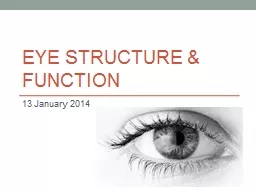/


Eye structure amp function 67 January 2016 Do Now Which fact is false Your eye muscles are the most active muscles in your body Newborns dont produce tears Corneal scratches heal in about 48 ID: 773601
Download Presentation The PPT/PDF document "Eye structure & function" is the property of its rightful owner. Permission is granted to download and print the materials on this web site for personal, non-commercial use only, and to display it on your personal computer provided you do not modify the materials and that you retain all copyright notices contained in the materials. By downloading content from our website, you accept the terms of this agreement.
Eye structure & function 6-7 January 2016
Do Now Which fact is false? Your eye muscles are the most active muscles in your body.Newborns don’t produce tearsCorneal scratches heal in about 48 hours.If you sit too close to a TV , computer, or tablet, you will damage your eyes.
External Eye & Accessory Structures Lacrimal refers to tears. Tears cleanse and lubricate the eyes, and also fight bacteria.
External Eye & Accessory Structures The lacrimal ducts empty into the nasal cavity this is why nose and eye irritation is often linked. you get the sniffles if cry and you get watery eyes if congested
External Eye & Accessory Structures Conjunctiva are the membranes the line the eyelid and eyeball. Conjunctivitis is inflammation of these membranes, caused by irritants, allergies, or infection (e.g. “pink eye”).
Extrinsic eye muscles Control movement of the eyes. Locations and functions can be reasoned out! Remember: rectus = straight, oblique = slanting Name Action Lateral rectus Medial rectus Superior rectus Inferior rectus Inferior oblique Superior oblique
Extrinsic eye muscles Control movement of the eyes. Locations and functions can be reasoned out! Remember: rectus = straight, oblique = slanting NameAction Lateral rectus Moves eye laterally Medial rectus Moves eye medially Superior rectus Moves eye up Inferior rectus Moves eye down Inferior oblique Moves eye up and laterally Superior oblique Moves eye down and laterally
Eyeball The eye has three tunics , or coats. Sclera – “whites of the eye” , outermost, thick connective tissue. Choroid – has blood vessels, middle layerRetina – contains the photoreceptors (rods & cones), inner layer
Eyeball The eye is divided into two fluid-filled chambers: The anterior chamber is filled with aqueous humor The posterior chamber is filled with vitreous humor Both fluids maintain eye pressure, and the aqueous humor nourishes the cornea and lens. Glaucoma occurs when the aqueous humor doesn’t drain properly, resulting in increased eye pressure and blindness.
Pathway of light Light enters the eye at the cornea – a clear, hard part of the sclera. Functions: protects eye and focuses light Fun fact: the cornea is responsible for ~70% of the eye’s focusing ability
Pathway of light Light passes through the pupil which is the opening in front of the lens. The size of the pupil is controlled by the muscles of the iris (the colored part of the eye). The pupil dilates or contracts to vary the amount of light hitting the retina.
Pathway of light The light passes through the lens , which focuses the light onto the retina. The ciliary body are muscles which change the shape of the lens to focus on nearby items, a process called accomodation.
Pathway of light 4. The light passes through the vitreous humor to land on the retina, which contains the photoreceptors. There are no photoreceptors on the optic disc, which is where the optic nerve exits the eye – this causes a small blind spot.
Photoreceptors Rods more abundant sensitive to low levels of light do not discriminate colors Cones 3 types, each sensitive to a different wavelengths t riggering of more than one cone is interpreted by brain as different colors e.g. if both red and green are activated, the brain will interpret the light as yellow or orange g reater resolution than cones Responsible for night and peripheral vision – that’s why colors seem to be lost in the dark Responsible for color and fine detail vision – including reading Watch me!
Color Blindness Color blindness is usually caused by the absence of one or more cones. Occurs in ~5% of populationX-linked trait … much more common in men
Color Blindness
Color Blindness
Color Blindness
Color Blindness
Color Blindness
Refraction & Accomodation Light is bent – or refracted – by nearly every eye structure that it passes through on the way to the retina. However the lens is the only structure that can vary how much the light is bent in order to allow us to focus on different objects – a process called accomodation. At rest, our eyes naturally focus on far-away objects. However, by contracting the ciliary body muscles, we can make the lens bulge so that it has greater refractive ability – allowing us to focus on close items. As we get older, our lens loses elasticity – making it harder to focus on nearby items. This condition is called presbyopia (old eyes)
Fun fact: Refraction flips and reverses the light rays, forming an upside down and reversed image on the retina … but the brain learns to interpret visual information correctly. Watch me!
What were our objectives, and what did you learn about them. What was our learner profile trait and how did we exemplify it?How does what we did today address our unit question? Closure
Exit Ticket Nine children attending the same day-care center developed red, inflamed eyes and eye lids. What is the most likely cause and name of this condition? Name two structures that help us to see in low light conditions. Why do you often have to blow your nose after crying? Name 4 substances that refract light? Which refracts light the most? Which is responsible for accomodation?